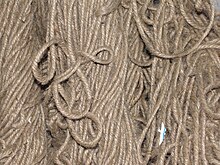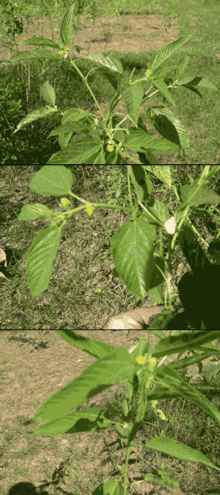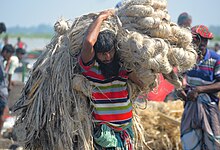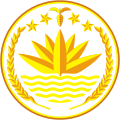Jute
This article has multiple issues. Please help improve it or discuss these issues on the talk page. (Learn how and when to remove these template messages)
|



Jute is a long, rough, shiny bast fibre that can be spun into coarse, strong threads. It is produced from flowering plants in the genus Corchorus, of the mallow family Malvaceae. The primary source of the fiber is Corchorus olitorius, but such fiber is considered inferior to that derived from Corchorus capsularis.[1]
Jute is one of the most affordable natural fibers and second to cotton in the amount produced and variety of uses. Jute fibers, composed primarily of cellulose and lignin, are collected from bast (the phloem of the plant, sometimes called the "skin") of plants like kenaf, industrial hemp, flax (linen), and ramie. The industrial term for jute fiber is raw jute. The fibers are off-white to brown and range from 1–4 meters (3–13 feet) long. In Bangladesh, jute is called the "golden fiber" for its color and high cash value.[2]
The bulk of the jute trade is centered in South Asia, with India and Bangladesh as the primary producers. The majority of jute is used for durable and sustainable packaging, such as burlap sacks. Its production and usage declined as disposable plastic packaging became common, but this trend has begun to reverse as merchants and even nations phase out or ban single-use plastics.[3][4]
Cultivation


The jute plant needs plain
White jute (Corchorus capsularis)
Historical documents (including or other agricultural products.
Tossa jute (Corchorus olitorius)
Tossa jute (.
Bangladesh and other countries in Southeast Asia, and the South Pacific mainly use jute for its fiber. Tossa jute fiber is softer, silkier, and stronger than white jute. This variety shows good sustainability in the Ganges Delta climate. Along with white jute, tossa jute has also been cultivated in the soil of Bengal where has been known as paat since the start of the 19th century. Coremantel, Bangladesh, is the largest global producer of the tossa jute variety. In India, West Bengal is the largest producer of jute.
History
Jute has been used for making
In classical antiquity, Pliny recorded that jute plants were used as food in Ancient Egypt.[8] It may have also been cultivated by the Jews in the Near East.[8]
For centuries, jute has been a part of the culture of Bangladesh and some parts of
Due to its coarse and tough texture, jute could initially only be processed by hand, until someone in
Production


The jute fiber comes from the stem and ribbon (outer skin) of the jute plant. The fibers are first extracted by retting, a process where jute stems are bundled together and immersed in slow running water. There are two types of retting: stem and ribbon.[clarification needed] After the retting process, stripping begins; women and children usually do this job. In the stripping process, workers scrape off non-fibrous matter, then dig in and grab the fibers from within the jute stem.[10][clarification needed]
Jute is a rain-fed crop with little need for fertilizer or pesticides, in contrast to cotton's heavy requirements.[citation needed][11] Production in India is concentrated mostly in West Bengal.[12] India is the world's largest producer of jute,[13][14] but imported approximately 162,000 tonnes[15] of raw fiber and 175,000 tonnes[16] of jute products in 2011. India, Pakistan, and China import significant quantities of jute fiber and products from Bangladesh, as do the United Kingdom, Japan, United States, France, Spain, Ivory Coast, Germany and Brazil. Jute and jute products formerly held the top position among Bangladesh's most exported goods, although now they stand second after ready-made apparel.[17] Annually, Bangladesh produces 7 to 8 million bales of raw jute, out of which 0.6 to 0.8 million bales are exported to international markets. China, India, and Pakistan are the primary importers of Bangladeshi raw jute.
| Country | Production (Tonnes) |
|---|---|
| 1,807,264 | |
| 804,520 | |
| 36,510 | |
| 19,122 | |
| 10,165 | |
| 3,677 | |
| 2,656 | |
| 2,276 | |
| 1,185 | |
| 342 | |
| World | 2,688,912 |
Genome
In 2002, Bangladesh commissioned a consortium of researchers from
Uses
Jutes are relatively cheap and versatile fiber and have a wide variety of uses in
The jute plant also has some culinary uses, which are generally focused on the leaves.
Due to its durability and biodegradability, jute matting is used as a temporary solution to prevent flood erosion.
Researchers have also investigated the possibility of using jute and
Fibers


Individual jute fibers can range from very fine to very coarse, and the varied fibers are suited for a variety of uses.
The coarser fibers, which are called jute butts, are used alone or combined with other fibers to make many products:
- Hessian cloth
- Sacking
- Agricultural wrapping cloth, most notably wrapping for bales of raw cotton
- Sandbags
- Cloth backing for flooring, such as linoleum or carpet
- Cordage, such as twine or rope
- Pulp (for paper production)
Finer jute fibers can be processed for use in:
- Shoes, such as espadrilles
- Sweaters and cardigans
- Imitation silk[citation needed]
- Curtains
- Chair coverings
- Carpets
- Rugs
Jute was historically[
Jute is used in the manufacture of fabrics, such as Hessian cloth, sacking, scrim, carpet backing cloth (CBC), and canvas. Hessian is lighter than sacking, and it is used for bags, wrappers, wall-coverings, upholstery, and home furnishings. Sacking, which is a fabric made of heavy jute fibers, has its use in the name. CBC made of jute comes in two types: primary and secondary. Primary CBC provides a tufting surface, while secondary CBC is bonded onto the primary backing for an overlay. Jute packaging is sometimes used as an environmentally friendly substitute for plastic.
Other jute consumer products include floor coverings,
Culinary uses
Corchous olitorius leaves are used to make
In India (West Bengal) and Bangladesh, in the Bengali cuisine, the fresh leaves are stir fried and eaten as path saak bhaja (পাঠ শাক ভাজা) along with a mustard sauce called kasundi (কাসুন্দি). The leaves are also eaten by making pakoras (পাঠ পাতার বড়া) with rice flour or Gram flour batter.
In Nigeria, leaves of Corchorus olitorius are prepared in sticky soup called ewedu together with ingredients such as sweet potato, dried small fish, or shrimp.[21] The leaves are rubbed until foamy or sticky before they are added to the soup. Among the Yoruba people of Nigeria, the leaves are called Ewedu, and in the Hausa-speaking northern Nigeria, the leaves are called turgunuwa or lallo. The cook shreds the jute leaves adds them to the soup, which generally also contains meat or fish, onions, pepper, and other spices. The Lugbara of Northwestern Uganda also eat jute leaves in a soup called pala bi. Jute is also a totem for Ayivu, one of the Lugbara clans.
In the
Vietnamese cuisine also use edible jute known as rau đay. It is usually used in canh cooked with crab and loofah.
In Haiti, a dish called "Lalo" is made with jute leaves and other ingredients. One version of Lalo includes lalo with crab and meat (such as pork or beef) served on a bed of rice.
Environmental impact
Fabrics made of jute fibers are
As global concern over
Cultural significance
National symbols
-
water lily are four starsand three connected jute leaves.
-
State emblem of Pakistan, Jute depicted in the fourth quarter.
-
Bangladesh Bank monogram, with three connected jute leaves at the base.
See also
- Cash crop
- Economy of Bangladesh
- International Jute Study Group
- International Year of Natural Fibres
- Kenaf
- Ministry of Textiles and Jute
- Spinning (textiles)
References
- ^ "Plants for a Future", Pfaf.org, archived from the original on 20 June 2015, retrieved 21 May 2015
- ^ "The Golden Fiber - Jute Farmers in Bangladesh – DW – 12/06/2023". dw.com. Retrieved 2024-04-12.
- ^ "Single-use plastics ban approved by European Parliament". BBC News. 24 October 2018. Retrieved 1 December 2023.
- ^ Yasir, Sameer (10 October 2022). "That Reusable Trader Joe's Bag? It's Rescuing an Indian Industry". The New York Times. Archived from the original on 11 October 2022. Retrieved 11 October 2022.
- ^ The New Bantam-Megiddo Hebrew & English Dictionary, Sivan and Levenston, Bantam books, NY, 1875
- ISBN 9780313334108.
- ^ "New evidence for jute (Corchorus capsularis L.) in the Indus civilization" (PDF). Harappa.com. Archived (PDF) from the original on 2019-01-08. Retrieved 2019-01-07.
- ^ ISBN 0415927463.
- ^ "BBC Two - Brian Cox's Jute Journey". BBC. 2010-02-24. Archived from the original on 2020-12-22. Retrieved 2016-09-20.
- ^ a b "Welcome to the world of Jute and Kenaf - IJSG". 26 May 2008. Archived from the original on 26 May 2008. Retrieved 27 April 2019.
- ^ "The Jute Story – From Empire to Oblivion and Back". Heritagepedia. 2022-05-15. Archived from the original on 2022-05-15. Retrieved 2022-05-26.
- ^ "Office of the Jute Commissioner — Ministry of Textiles". Jutecomm.gov.in. 2013-11-19. Archived from the original on 2019-09-19. Retrieved 2014-01-09.
- ^ "Statistics — World production of Jute Fibres from 2004/2005 to 2010/2011". International Jute Study Group (IJSG). 2013-11-19. Archived from the original on 2020-07-05. Retrieved 2014-01-09.
- ^ Kumari, Kalpana; S R, Devegowda; Kushwaha, Saket (2018). "Trend analysis of area, production and productivity of jute in India" (PDF). The Pharma Innovation Journal. 7 (12): 394–399. Archived (PDF) from the original on 2020-12-01. Retrieved 2020-09-04.
- ^ "Statistics — World Import of raw Jute, Kenaf and Allied Fibres". International Jute Study Group (IJSG). 2013-11-19. Archived from the original on 2018-02-25. Retrieved 2014-01-09.
- ^ "Statistics — World Imports of Products of Jute, Kenaf and Allied Fibres". International Jute Study Group (IJSG). 2013-11-19. Archived from the original on 2020-07-05. Retrieved 2014-01-09.
- ^ "Top 10 Most Exported Products of Bangladesh". Business Inspection BD. 2022-09-28. Archived from the original on 2022-11-27. Retrieved 2023-07-24.
- ^ "FAOSTAT – Crops" (Query page requires interactive entry in four sections: "Countries"–Select All; "Elements"–Production Quantity; "Items"–Jute; "Years"–2020). Food And Agricultural Organization of United Nations: Economic And Social Department: The Statistical Division. 2017-02-13. Archived from the original on 2023-10-16. Retrieved 2022-05-17.
- ^ "The Jute Genome Project Homepage". Jutegenome.org. Archived from the original on 2010-06-19. Retrieved 2010-06-17.
- ^ "SUGAR AND JUTE AEROPLANE PANELS". Archived from the original on 2015-04-15.
- ^ AVRDC. Recipes - African Sticky Soup (Ewedu) Archived 2013-10-17 at the Wayback Machine. Retrieved 27 June 2013.
Further reading
- Basu, G., A. K. Sinha, and S. N. Chattopadhyay. "Properties of Jute Based Ternary Blended Bulked Yarns". Man-Made Textiles in India. Vol. 48, no. 9 (Sep. 2005): 350–353. (AN 18605324)
- Chattopadhyay, S. N., N. C. Pan, and A. Day. "A Novel Process of Dyeing of Jute Fabric Using Reactive Dye". Textile Industry of India. Vol. 42, no. 9 (Sep. 2004): 15–22. (AN 17093709)
- Doraiswamy, I., A. Basu, and K. P. Chellamani. "Development of Fine Quality Jute Fibers". Colourage. Nov. 6–8, 1998, 2p. (AN TDH0624047199903296)
- Kozlowski, R., and S. Manys. "Green Fibers". The Textile Institute. Textile Industry: Winning Strategies for the New Millennium—Papers Presented at the World Conference. Feb. 10–13, 1999: 29 (13p). (AN TDH0646343200106392)
- Madhu, T. "Bio-Composites—An Overview". Textile Magazine. Vol. 43, no. 8 (Jun. 2002): 49 (2 pp). (AN TDH0656367200206816)
- Maulik, S. R. "Chemical Modification of Jute". Asian Textile Journal. Vol. 10, no. 7 (Jul. 2001): 99 (8 pp). (AN TDH0648424200108473)
- Moses, J. Jeyakodi, and M. Ramasamy. "Quality Improvement on Jute and Jute Cotton Materials Using Enzyme Treatment and Natural Dyeing". Man-Made Textiles in India. Vol. 47, no. 7 (Jul. 2004): 252–255. (AN 14075527)
- Pan, N. C., S. N. Chattopadhyay, and A. Day. "Dyeing of Jute Fabric with Natural Dye Extracted from Marigold Flower". Asian Textile Journal. Vol. 13, no. 7 (Jul. 2004): 80–82. (AN 15081016)
- Pan, N. C., A. Day, and K. K. Mahalanabis. "Properties of Jute". Indian Textile Journal. Vol. 110, no. 5 (Feb. 2000): 16. (AN TDH0635236200004885)
- Roy, T. K. G., S. K. Chatterjee, and B. D. Gupta. "Comparative Studies on Bleaching and Dyeing of Jute after Processing with Mineral Oil in Water Emulsion vis-a-vis Self-Emulsifiable Castor Oil". Colourage. Vol. 49, no. 8 (Aug. 2002): 27 (5 pp). (AN TDH0657901200208350)
- Shenai, V. A. "Enzyme Treatment". Indian Textile Journal. Vol. 114, no. 2 (Nov. 2003): 112–113. (AN 13153355)
- Srinivasan, J., A. Venkatachalam, and P. Radhakrishnan. "Small-Scale Jute Spinning: An Analysis". Textile Magazine. Vol. 40, no. 4 (Feb. 1999): 29. (ANTDH0624005199903254)
- Tomlinson, Jim. Carlo Morelli and Valerie Wright. The Decline of Jute: Managing Industrial Decline (London: Pickering and Chatto, 2011) 219 pp. ISBN 978-1-84893-124-4. focus on Dundee, Scotland
- Vijayakumar, K. A., and P. R. Raajendraa. "A New Method to Determine the Proportion of Jute in a Jute/Cotton Blend". Asian Textile Journal, Vol. 14, no. 5 (May 2005): 70–72. (AN 18137355)
External links
- Jute Genome Project
- Bangladesh Jute Research Institute
- International Jute Study Group (IJSG) Resources about jute, kenaf, and roselle plants. jute.org
- Department of Horticulture & Landscape Architecture, Purdue University Some chemistry and medicinal information on tossa jute. purdue.edu
- National Library of Scotland: SCOTTISH SCREEN ARCHIVE (selection of archive films about the jute industry in Dundee)



